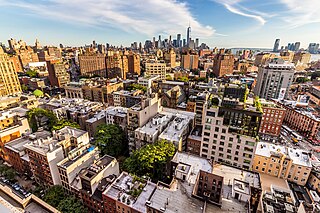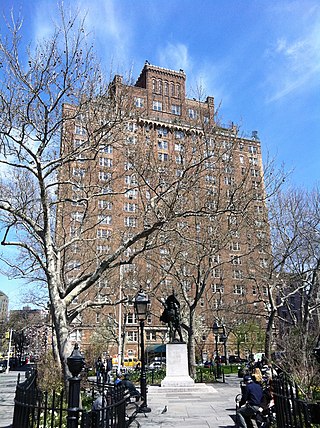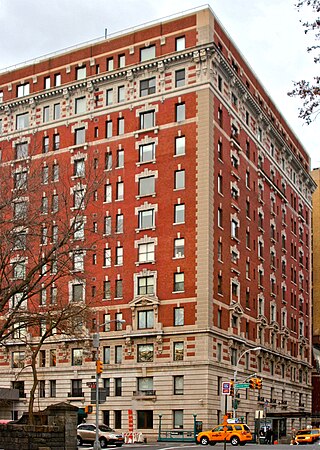
Greenwich Village, or simply the Village, is a neighborhood on the west side of Lower Manhattan in New York City, bounded by 14th Street to the north, Broadway to the east, Houston Street to the south, and the Hudson River to the west. Greenwich Village also contains several subsections, including the West Village west of Seventh Avenue and the Meatpacking District in the northwest corner of Greenwich Village.

The Dakota, also known as the Dakota Apartments, is a cooperative apartment building at 1 West 72nd Street on the Upper West Side of Manhattan in New York City, United States. The Dakota was constructed between 1880 and 1884 in the German Renaissance style and was designed by Henry Janeway Hardenbergh for businessman Edward Cabot Clark. The building was one of the first large developments on the Upper West Side and is the oldest remaining luxury apartment building in New York City. The building is a National Historic Landmark and has been designated a city landmark by the New York City Landmarks Preservation Commission. The building is also a contributing property to the Central Park West Historic District.

55 Central Park West is a 19-floor housing cooperative on the Upper West Side of Manhattan in New York City. Built in 1929, it was designed by the architectural firm Schwartz & Gross. The building is a contributing property within the Central Park West Historic District, which is listed on the National Register of Historic Places.

The Wilbraham is an apartment building at 282–284 Fifth Avenue and 1 West 30th Street in the Midtown South neighborhood of Manhattan in New York City. The nine-story structure was designed by David and John Jardine in the Romanesque Revival style, with elements of the Renaissance Revival style, and occupies the northwestern corner of 30th Street and Fifth Avenue. It was built between 1888 and 1890 as a bachelor apartment hotel. The New York City Landmarks Preservation Commission has designated the Wilbraham as an official city landmark, and the building is listed on the National Register of Historic Places.
Bing & Bing was one of the most important apartment real estate developers in New York City in the early 20th century.

45 Christopher Street is a residential building on the north side of Christopher Street, near Christopher Park, in the Greenwich Village neighborhood of Manhattan in New York City.

The Belnord is a condominium building at 225 West 86th Street on the Upper West Side of Manhattan in New York City. The 13-story structure was designed by Hiss and Weekes in the Italian Renaissance Revival style and occupies the full block between Broadway, Amsterdam Avenue, and 86th and 87th Streets. It was built between 1908 and 1909 by a syndicate of investors as a rental apartment building. The Belnord is a New York City designated landmark and is listed on the National Register of Historic Places.

The Osborne, also known as the Osborne Apartments or 205 West 57th Street, is an apartment building at Seventh Avenue and 57th Street in Midtown Manhattan in New York City. The original portion of the Osborne was designed by James Edward Ware and constructed from 1883 to 1885. An annex to the west, designed by Alfred S. G. Taylor and Julian Clarence Levi, was constructed in 1906. The Osborne is one of the oldest extant luxury apartment buildings in New York City.

2-10 Horatio Street is a 17-story co-operative apartment building located between Greenwich and Eighth Avenues, on the corner of Greenwich Avenue, across from Jackson Square Park in the Greenwich Village neighborhood of Manhattan, New York City, United States. Built in 1929–31 and designed by Robert T. Lyons, the building is located within the Greenwich Village Historic District, but is not an individual landmark. The building also has the address 123-129 Greenwich Avenue.

Robert Timothy Lyons was an architect responsible for many residential and commercial buildings in New York City in the early 20th century. He typically built in a Renaissance Revival or Neo-Federal style.

299 West 12th Street is a residential building facing south onto Abingdon Square Park in the Greenwich Village Historic District on the west side of Lower Manhattan in New York City. It was built by the developer brothers Bing & Bing and noted architect Emery Roth whose other works include The Beresford and The El Dorado.

302 West 12th Street is a residential building facing west onto Abingdon Square Park in the Greenwich Village Historic District on the west side of lower Manhattan, New York City, United States.

Charles Vincent Paterno was an Italian-born American real estate developer. He was called the "Napoleon of the Manhattan Skyscraper Builders".

257 Central Park West is a co-op apartment building on the southwest corner of 86th Street and Central Park West in the Upper West Side of Manhattan in New York City. It was designed by the firm of Mulliken and Moeller and built by Gotham Building & Construction between 1905 and 1906.
Henry Elghanayan is an Iranian-born American real estate developer who co-founded and is the current chairman the Rockrose Development Corporation.

Butterfield House is a cooperative apartment building on West 12th Street in the West Village neighborhood of Manhattan, New York City. It was designed by the architects and urban planners William J. Conklin and James Rossant then of Mayer, Whittlesey & Glass. It is situated between Fifth Avenue and Sixth Avenue within the Greenwich Village Historic District. The building was described in The New York Times as "a modernist landmark" that "received numerous accolades when it was built in 1962".
1020 Fifth Avenue is a luxury housing cooperative in the Upper East Side of Manhattan, New York City. It is located on the northeast corner of 83rd Street and Fifth Avenue, across the street from the Metropolitan Museum of Art's Fifth Avenue building. It is part of the Metropolitan Museum Historic District. Along with 1040 Fifth Avenue and 998 Fifth Avenue, it is considered among the most prestigious residential buildings in New York City and is frequently included in lists of top residential buildings. Sales of units in the building are often reported by the press. Former New York Times architectural critic Carter Horsley describes the building as "[o]ne of the supreme residential buildings of New York". The building is profiled in multiple architectural books, including in Windows on the Park: New York's most prestigious properties on Central Park, where it is described as "one of the city's most exclusive addresses".

Sutton House is a three-building residential cooperative with a private garden at 415 East 52nd Street on the Turtle Bay neighborhood of Manhattan in New York City. The building was designed by John M. Kokkins and Stephen C. Lyras in the modern style and was built by Kolyer Construction Corporation, originally as a luxury rental building managed by Douglas Elliman and owned by seven owners, including Kokkins, Lyras, Greek executive Manuel Kulukundis. The 19-floor building C faces East 53rd Street, and is technically, therefore, part of the Sutton Place neighborhood, while the 12-floor buildings A and B face East 52nd Street. Constructed between 1954 and 1956, Sutton House was developed to be a "Symbol of town Living for Perfectionists", per its marketing brochure found at Columbia University New York Real Estate Brochure Collection.

White brick buildings became common in New York City during the 1950s, even though they were not totally unknown to the city before that, as the 1907 Plaza Hotel shows. That said, between the 1950s and 1970s, around 140 white brick apartments were built in the city, defining a lot of its post-war character. Since 2008, white brick buildings became recognized as an important element in New York, with the requirement of the first landmark restoration of such as building: the 1960 co-op at 900 Fifth Avenue. As white brick buildings age, they are considered to require higher maintenance than other construction styles.
















